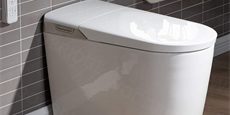Sustainability is a growing concern, and smart toilets are making significant strides in water conservation and eco-friendliness. Here’s how smart toilets contribute to sustainability:
- Efficient Water Usage: Smart toilets are equipped with water-saving features, such as dual-flush systems that allow users to choose between a full flush for solid waste and a reduced flush for liquid waste. This significantly reduces water consumption.
- Low-Flow Flushing: Many smart toilets incorporate low-flow flushing mechanisms that use less water per flush while maintaining effective waste removal.
- Advanced Flush Technologies: Some models use pressure-assisted flushing technology, which generates a powerful flush with less water, reducing water usage without compromising performance.
- Integrated Bidets: Smart toilets with integrated bidet functions use water for cleansing, reducing the need for toilet paper. This not only saves water but also reduces paper waste.
- Smart Water Management: Advanced models may feature sensors and algorithms that optimize water usage based on user behavior, further reducing water waste.
- Environmental Certifications: Look for smart toilets with environmental certifications such as WaterSense or LEED compliance to ensure they meet strict sustainability standards.
- Longevity: Smart toilets are known for their durability, reducing the need for frequent replacements and minimizing waste.
- Smart Controls: Some smart toilets offer water temperature and pressure controls for bidet functions, allowing users to customize their experience while promoting water conservation.
Choosing a smart toilet is not just a convenience; it’s also an eco-conscious decision that aligns with sustainability goals and contributes to a more environmentally responsible home. As technology continues to advance, smart toilets will play a crucial role in promoting water efficiency and reducing our environmental footprint.








